Tired of knee pain from skiing? Here’s the solution: Snowfeet offers a lightweight, shorter alternative to traditional skis, designed to reduce knee strain and make winter sports more enjoyable. Unlike heavy skis that increase joint stress, Snowfeet’s compact design minimizes torque and absorbs shocks, offering a safer, more comfortable experience.
Key benefits of Snowfeet:
- Knee-Friendly Design: Shorter skis (17–47 inches) decrease rotational force and strain.
- Versatility: Works with regular winter shoes or snowboard boots.
- Affordable: Starting at $140, much cheaper than traditional ski setups.
- Portable: Fits in a backpack, no bulky gear needed.
Why switch? Traditional skis are heavy, long, and hard on your knees, especially in icy or uneven conditions. Snowfeet’s shorter length and flexible build offer a gentler, more accessible way to enjoy the slopes. Plus, they’re great for all skill levels and terrains.
Quick Comparison:
| Feature | Traditional Skis (Rossignol, Atomic) | Snowfeet (Skiskates, Skiblades) |
|---|---|---|
| Length | 5–6 feet (150–180 cm) | 17–47 inches (44–120 cm) |
| Knee Strain | High | Low |
| Price | $800–$1,500+ | $140–$650 |
| Portability | Requires ski bags or roof racks | Fits in a backpack |
| Footwear | Ski boots | Regular winter or snowboard boots |
If you’re looking for a low-impact, budget-friendly way to enjoy winter sports without knee pain, Snowfeet is worth considering. Let’s dive deeper into how they work and why they’re a great alternative.
Simple Exercises for Skiers to Avoid Knee Pain
Understanding Knee Strain in Traditional Skiing
Ever wonder why your knees feel like they're staging a protest after a day on the slopes? The answer lies in the intense forces your body endures when strapped into traditional skis. The design of conventional skiing gear puts a lot more stress on your knees than you might think.
Biomechanical Forces in Traditional Skiing
Let’s start with the skis themselves. Brands like Rossignol and Atomic make heavy skis that extend your lever arm by 5–6 times. This dramatically increases the forces acting on your knees.
"Give me a lever long enough with a fulcrum to place on it and I will move the world."
Now, pair those skis with rigid boots. These boots lock your ankles in place, leaving your knees, hips, and lower back to absorb all the shocks. Your ankles, which are supposed to help handle terrain changes, can’t do their job. So, your knees end up taking the hit - literally.
Even modern skis, like those from Head or Elan, which offer better torsional rigidity and flexibility, can still pose risks. Skis that grip too tightly or turn too easily can force your knee into dangerous twisting motions. Picture this: your ski and tibia carve across the slope while your body keeps moving downhill. Ouch.
The stats are pretty alarming. About one-third of all skiing injuries involve the knee, and of those, 38% are ACL tears. The ACL is particularly vulnerable when your knee collapses inward (valgus position), hyperextends, or rotates excessively inward. Long skis, which are more likely to get caught and generate massive force, increase the risk of these injuries even further.
But it’s not just the equipment. The terrain and weather also play a huge role in how much strain your knees endure.
Terrain and Environmental Challenges
Snow conditions can make or break your day - and your ACL. Compared to soft, slushy snow, skiing on fresh snow increases your ACL injury risk by 10.5 times. Grippy snow? That’s 7.8 times higher. And icy conditions? A whopping 12.4 times higher. For women, the risk on icy slopes skyrockets to 24 times compared to soft snow.
| Snow Condition | ACL Injury Risk Increase |
|---|---|
| Fresh Snow | 10.5x higher |
| Grippy Snow | 7.8x higher |
| Icy Conditions | 12.4x higher |
| Icy (Female Skiers) | 24x higher |
Temperature also matters. Cold weather, especially between –4°F and 18°F (–20°C to –8°C), increases the risk of ACL injuries by 1.6 times for all skiers and peaks for women in these frigid conditions. Harder snow surfaces in cold weather amplify impact forces during falls, while cold muscles - especially knee flexors - struggle to generate explosive power.
Fresh snowfall adds another layer of risk. It hides bumps and uneven terrain, making it easier to catch an edge. Knee injuries are twice as common during snowfall compared to clear days. And icy patches? They can throw off your balance in an instant, leading to falls and twisted knees.
All of this adds up to a tough reality: heavy traditional gear combined with challenging snow conditions puts a lot of strain on your knees. While modern quick-release bindings have reduced leg fractures by about 90% over the last few decades, knee injuries like twists and tears have become more common as a trade-off.
This is why exploring low-impact alternatives, like Snowfeet, might be worth considering. They could save your knees a lot of trouble.
Introducing Snowfeet: A Gentler Way to Enjoy Snow Sports
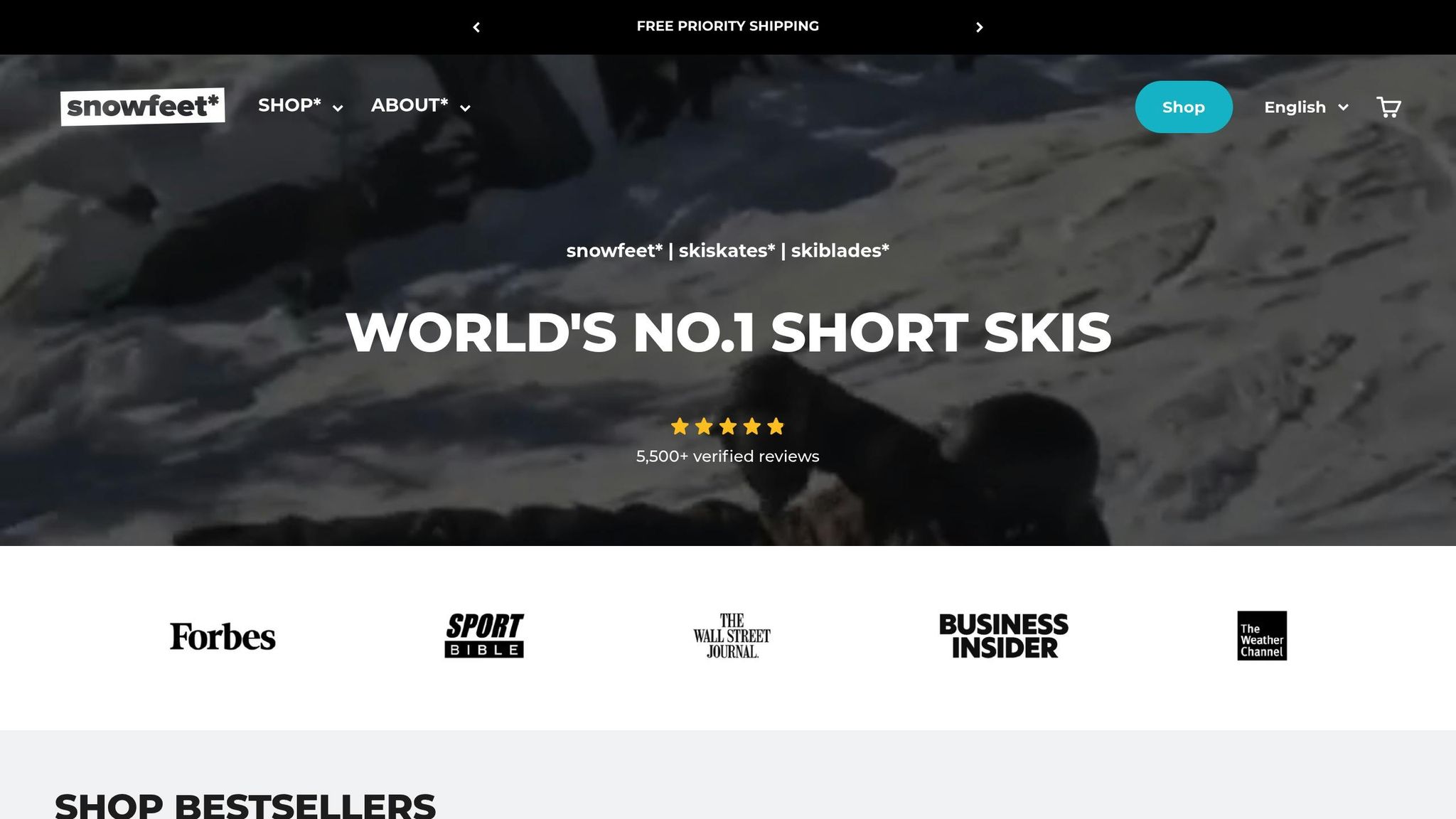
If you're worried about knee strain from traditional skiing, there's a game-changing alternative you should know about: Snowfeet. These short skis are designed to work with your body's natural movements, helping to reduce the stress on your knees. Here's how their clever design makes a difference.
Lightweight and Compact: A Smarter Design for Your Knees
Most traditional skis, like those from brands such as Head or Elan, are around 5 to 6 feet long (150–180 cm). Snowfeet, on the other hand, are much shorter - ranging from just 17 inches to 47 inches (44–120 cm). Why does this matter? The shorter length significantly reduces the "lever arm effect", which is just a fancy way of saying there's less torque pulling on your knees.
Take Skiskates, for example. At just 44 cm, they’re the shortest skis in the world. This compact size means less leverage on your joints, making them easier on your knees. Plus, their smaller turning radius and lightweight design mean you use less effort to move, reducing twisting and strain.
But it doesn’t stop there. Snowfeet's wider profile and flexible construction help absorb shocks and vibrations from uneven terrain. Think of them as built-in shock absorbers for your joints, giving you better control and reducing your chances of falling. It’s a win-win for your knees and your confidence.
Flexible Footwear Options for Extra Comfort
Another way Snowfeet stands out is in its versatility. Unlike traditional skis that require stiff, heavy ski boots, Snowfeet can attach to regular winter shoes or snowboard boots. Thanks to adjustable bindings, they fit a wide range of shoe sizes (6–13 US or 38–47 EU), allowing your ankles to move naturally. This is key - when your ankles can handle terrain changes, your knees don’t have to work as hard.
Depending on your activity, you can pair Snowfeet with different footwear. Snowboard boots are great for ski slopes, while regular winter shoes are perfect for hiking or sledding. Plus, they’re super easy to attach and remove, making them a family-friendly option for all kinds of winter adventures.
Snowfeet Lineup: Skiskates, Skiblades, and MINI KIDS
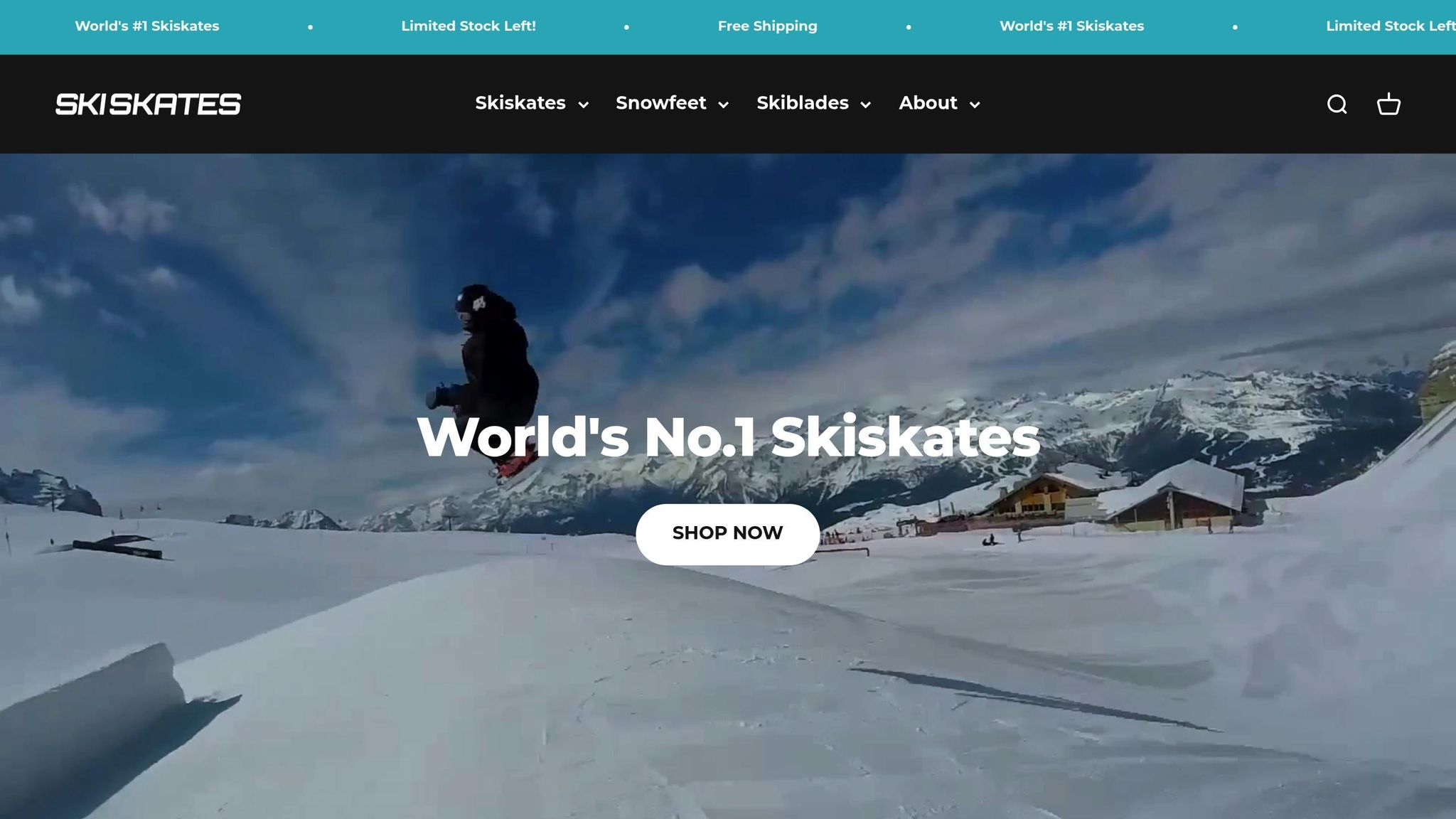
Snowfeet offers a variety of products designed for different ages, skill levels, and preferences - all with your knees in mind.
- Skiskates (44 cm): Compact enough to fit in a backpack, these are perfect for everything from ski slopes to backyard fun.
- Skiblades: With options at 65 cm, 99 cm, and 120 cm, these are great for carving and snowpark tricks. The 65 cm version balances stability and maneuverability, while the longer models offer versatility across different terrains.
- Snowfeet MINI KIDS: Made for young snow lovers, these mini skis help kids learn proper technique without the hassle of bulky, heavy gear.
Every Snowfeet product is designed for a variety of terrains - whether it’s slopes, parks, hiking trails, or even your backyard. They’re easy to learn, gentle on your joints, and packed with fun. With Snowfeet, you’re not just getting a new pair of skis - you’re getting a whole new way to enjoy snow sports while keeping your knees happy and healthy.
Snowfeet vs. Traditional Ski Brands
If knee pain is cutting into your skiing fun, comparing Snowfeet to traditional brands like Rossignol, Atomic, and Head might just surprise you. Let’s break down the differences in performance and cost to see why Snowfeet stands out.
Performance and Knee Stress Comparison
When it comes to saving your knees, ski length plays a huge role. Traditional skis are usually around 5–6 feet long (150–180 cm), while Snowfeet products are much shorter, ranging from 17 to 47 inches (44–120 cm). This shorter length reduces the rotational force on your knees during turns and creates a tighter turning radius, making turns feel easier and less straining.
"Yes, short skis are better for the knees. Skiing with longer skis becomes more demanding on knees with age. Shorter skis require less pressure on knees", says the Snowfeet Team.
Snowfeet’s compact design also means you won’t need as much edge pressure, which helps limit knee rotation. Plus, their softer flex pattern absorbs shocks and vibrations from bumpy terrain, offering built-in knee protection.
"Short skis aka skiboards / snowblades / skiblades can be better for older skiers because they are easier to control and maneuver, which can reduce the risk of falls and injuries", adds the Snowfeet Team.
Affordability and Accessibility
Price and convenience are where Snowfeet really shine. A full traditional ski setup - skis, bindings, boots, and poles - can cost anywhere from $800 to $1,500 or more. Snowfeet, on the other hand, offers options starting at just $140 for Mini Ski Skates, with their longest Short Skis priced at $650.
| Equipment Type | Traditional Brands | Snowfeet | Savings |
|---|---|---|---|
| Entry-level setup | $800–$1,000 | $140–$230 | $570–$860 |
| Mid-range setup | $1,000–$1,200 | $330–$450 | $550–$870 |
| Premium setup | $1,200–$1,500+ | $450–$650 | $550–$1,000+ |
Another bonus? Snowfeet gear works with regular winter or snowboard boots - no need for expensive, custom-fitted ski boots. And when it’s time to pack up, Snowfeet are compact enough to fit into a standard backpack, unlike traditional skis that require bulky roof racks or ski bags.
Maintenance is also simpler with Snowfeet. Traditional skis often need waxing, edge tuning, and repairs, which can add up. Snowfeet’s fiberglass construction is durable and low-maintenance, with accessories like wax costing as little as $6 if needed.
With their knee-friendly design, affordable pricing, and easy portability, Snowfeet are a fantastic alternative for anyone looking to enjoy winter sports without the hassle - or the knee pain.
sbb-itb-17ade95
Other Low-Impact Snow Sports
Looking for more ways to enjoy winter fun while being kind to your knees? These low-impact activities pair perfectly with your Snowfeet adventures, giving you plenty of options to stay active without stressing your joints.
Snowshoeing
Snowshoeing is about as gentle as winter activities get. Thanks to the snow’s cushioning effect, each step absorbs impact, making it much easier on your joints compared to walking on hard surfaces.
Getting started is simple. All you need is a sturdy pair of snowshoes, adjustable poles with snow baskets, waterproof boots with good insulation, and breathable outerwear. For soft, powdery snow, go with tubular snowshoes; for packed trails, composite models are your best bet.
On top of being easy on your knees, snowshoeing is a serious calorie burner. You can torch up to 1,000 calories per hour, giving you a workout similar to running or hiking, but with far less strain on your joints.
Ice Skating
Ice skating combines fun with fitness, offering an aerobic workout that’s easier on your knees than jogging. The smooth, gliding motion generates less than half the impact shock of light jogging, making it a great option if you’re managing knee pain or arthritis.
Not only does skating keep your joints flexible and prevent stiffness, but it also strengthens key muscle groups like your quadriceps, hamstrings, and hips. Over time, this can boost knee stability. Depending on your pace and intensity, you can burn anywhere from 300 to 600 calories per hour.
Before hitting the ice, take a few minutes to stretch and warm up - your knees will thank you.
Fat Biking
Fat biking is another winter sport that’s easy on the knees and growing in popularity. These bikes are equipped with oversized tires that distribute weight more evenly, letting you cruise over snow-covered trails with ease.
Cycling is naturally gentle on the joints and can even strengthen the muscles around your knees, reducing discomfort over time. Just make sure your bike is properly fitted to avoid unnecessary strain on your back, hips, or knees.
If you’re new to fat biking, rentals are widely available at winter destinations. Expect to pay around $40–60 per day for a bike, with trail passes costing about $10–20.
Mix It Up
Rotating these activities with your Snowfeet sessions is a great way to protect your joints while still making the most of winter. Together, they offer a well-rounded approach to staying active and enjoying the snowy season without sacrificing your knee health.
Getting Started with Snowfeet
Switching to Snowfeet is a breeze, especially if traditional skis have been rough on your knees. These shorter, lighter skis are easier on your joints and offer a smoother learning curve.
Beginner Tips
Getting the hang of Snowfeet might feel different at first, but the basics are pretty straightforward. Start with a centered, shoulder-width stance - no leaning forward like you would on traditional skis. Keep your weight balanced over the middle and back of your feet.
For added stability, try positioning one foot slightly ahead of the other. This small tweak can help you stay balanced, especially while adjusting to the shorter length. Keep your knees bent to absorb bumps and maintain control. If you feel yourself wobbling, lean forward a bit and stretch out your arms to steady yourself.
Movement with Snowfeet is a mix of skiing and skating. Push off to the side, like you would when ice skating, instead of the straight-ahead motion used in regular skiing. If you’ve ever skated or played hockey, this will feel second nature.
To stop, distribute your weight evenly on both feet. You can also use the heel brake to slow down - just make sure your weight is balanced as you come to a stop.
Turning is similar to traditional skiing. Angle your Snowfeet and lean your body in the direction you want to go. The shorter length makes turns quicker and easier to control, which is great when you’re just starting out.
Once you’ve nailed the basics, you can start tackling more advanced techniques and terrains.
Advanced Techniques for Experienced Skiers
If you’re a seasoned skier used to brands like Rossignol or Atomic, you’ll need to tweak your approach to get the most out of Snowfeet. Their shorter design changes how you handle different slopes and conditions.
Snowfeet shine on groomed snow, so that’s the best place to practice advanced moves. Hold off on steep slopes or deep powder until you’re fully comfortable. The 44 cm Skiskates and 65 cm Skiblades are ideal for freestyle skiing and tricks in the snowpark, while the 99 cm Skiblades offer better support for carving and all-mountain skiing. These longer models give experienced skiers a feel that’s closer to traditional skis but still offer the agility of Snowfeet.
For advanced terrain, focus on refining your weight distribution to make quicker turns. Snowfeet’s responsiveness makes navigating tight or technical areas much easier.
Maintaining Snowfeet for Best Performance
Taking good care of your Snowfeet is just as important as perfecting your technique. Proper maintenance keeps them performing smoothly and protects their joint-friendly benefits.
- Wax regularly: This improves glide and prevents snow from sticking.
- Clean and dry after use: Wipe them down to prevent rust and fix any minor damage before it gets worse.
- Off-season storage: Apply a thick coat of wax to the base before storing. Keep them in a cool, dry spot, away from sunlight. Use edge guards to protect them during transport and storage.
Professional skier Matej Kovačič shares his routine for off-season care:
"I clean the skis with a damp cloth and dry them well. I fill damage on the base and clean it with a rough brush. Then I apply a large amount of wax over the entire base and edge with the help of an iron. I leave the wax on and put the skis in a dry and cool place. The ski is protected for summer now."
With the right care, your Snowfeet will stay in top shape, giving you a lightweight, knee-friendly alternative to traditional skis. Enjoy hitting the slopes without the extra strain!
Conclusion: Winter Fun Without the Knee Pain
Knee pain doesn’t have to sideline your winter adventures. Snowfeet products provide a refreshing alternative, offering a way to hit the slopes with less strain on your joints compared to traditional gear from brands like Rossignol, Atomic, or Head.
The secret lies in their shorter ski designs. These require less effort to turn and absorb shocks more effectively, which means reduced pressure on your knees. Snowfeet offers options ranging from compact skiskates (around 1.4 ft) to longer models (up to 4 ft), giving you both control and enjoyment while being gentler on your joints.
Starting at just $140, Snowfeet is a budget-friendly choice for those looking to enjoy knee-friendly winter sports. Unlike the hefty price tags of traditional ski equipment, Snowfeet combines affordability with reduced physical demand, making it an appealing option for protecting your knees without breaking the bank.
Snowfeet also stands out for its versatility. Whether you’re into the freestyle fun of skiskates, the carving precision of skiblades, or the all-mountain versatility of their longer models, there’s something to match your style and comfort. This flexibility lets you customize your winter experience to suit your body and preferences.
The lightweight, portable design and compatibility with a wide range of boots mean you won’t need to invest in extra gear or worry about added strain.
Winter is meant to be enjoyed, not endured. With Snowfeet’s thoughtful design and knee-friendly approach, you can embrace the snow without the discomfort. Sometimes, smaller really is better - for your knees and your overall winter experience.
FAQs
Why are Snowfeet easier on the knees compared to traditional skiing gear?
Why Snowfeet Products Are Easier on Your Knees
Snowfeet gear, like Skiskates and Skiblades, is designed to be kinder to your knees compared to traditional skis or snowboards. Here's why: standard skis are typically 5 to 7 feet long, which can put a lot of twisting force on your knees during turns. Snowfeet products, on the other hand, are much shorter - ranging from just 17 to 47 inches. This compact size means less strain on your joints, making turns smoother and more comfortable.
Another big plus? Snowfeet gear is super lightweight. This not only reduces fatigue but also minimizes the stress on your knees and other joints as you glide through the snow. Plus, their sleek design gives you better control and makes them easier to maneuver, so you can enjoy winter sports without feeling like you're wrestling with your equipment.
Whether you're bouncing back from an injury or just looking for a gentler, more enjoyable way to hit the slopes, Snowfeet offers a low-impact, fun alternative to traditional skiing.
What kind of shoes can you use with Snowfeet? Do you need special boots?
Snowfeet are built to be super versatile, meaning you don’t need any fancy or specific boots to use them. They work with regular winter shoes, snowboard boots, and even ski boots. That said, for the best ride, it’s a good idea to go with waterproof shoes that have solid ankle support. Snowboard boots tend to be a fan favorite - they’re comfy, provide great side-to-side support, and feel just right for Snowfeet. Ski boots can also fit into Snowfeet’s binding system, but snowboard boots often win out because they’re lighter and allow more flexibility on the slopes.
What types of snow conditions or terrains are best suited for Snowfeet compared to traditional skis?
Snowfeet products, much like skiblades, shine on groomed slopes and soft snow. Thanks to their shorter length and lightweight build, they offer excellent maneuverability and control, making them a great pick for recreational skiers or anyone looking for a low-effort, easy-to-use alternative to traditional skis.
That said, when it comes to deep powder or icy terrain, traditional skis from brands like Rossignol or Atomic take the lead. Their longer and wider design provides better stability and float, especially at higher speeds or in tougher conditions. While Snowfeet might not be the top choice for extreme skiing, they’re an awesome option for casual skiers who want something fun, versatile, and easier on the joints.





















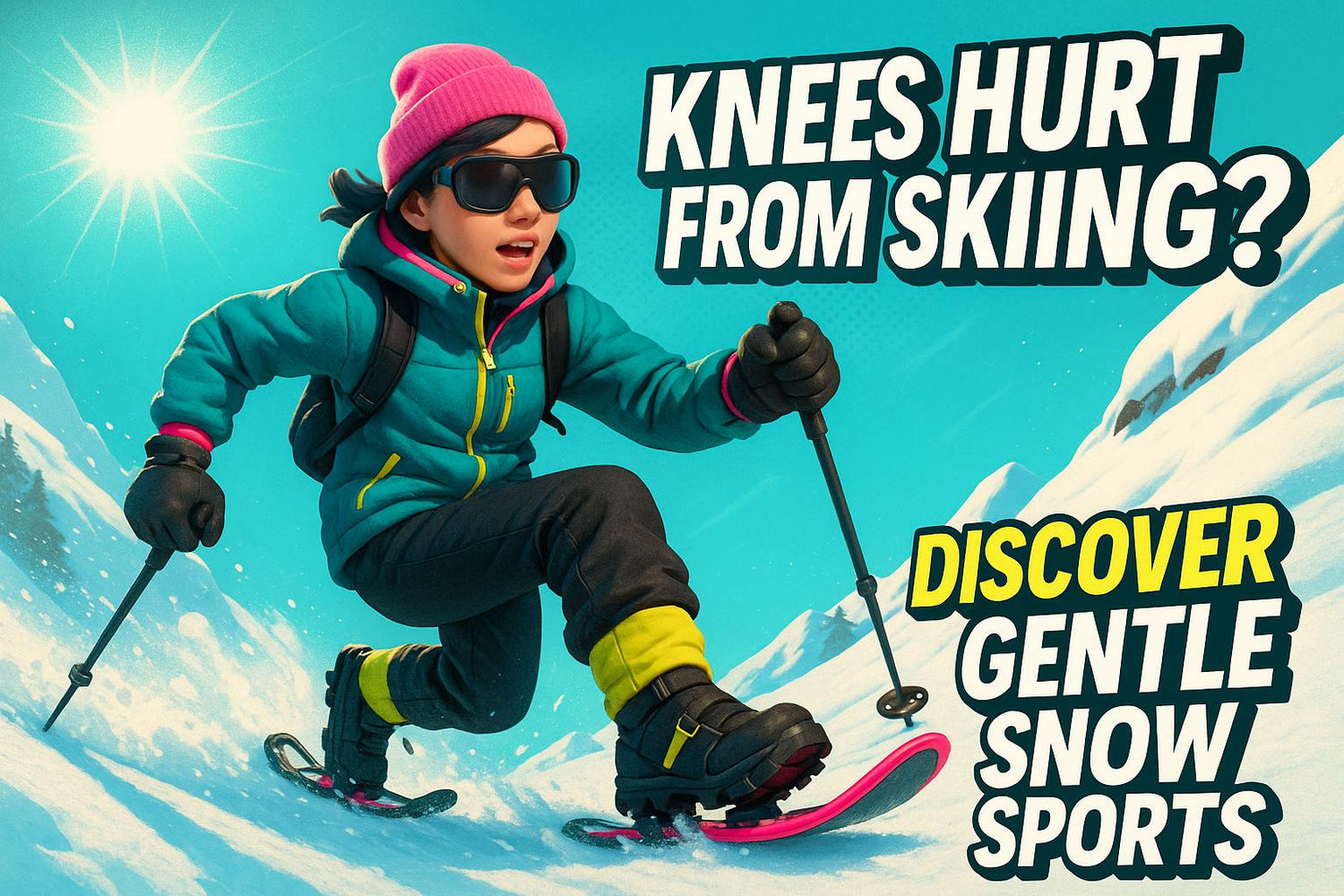
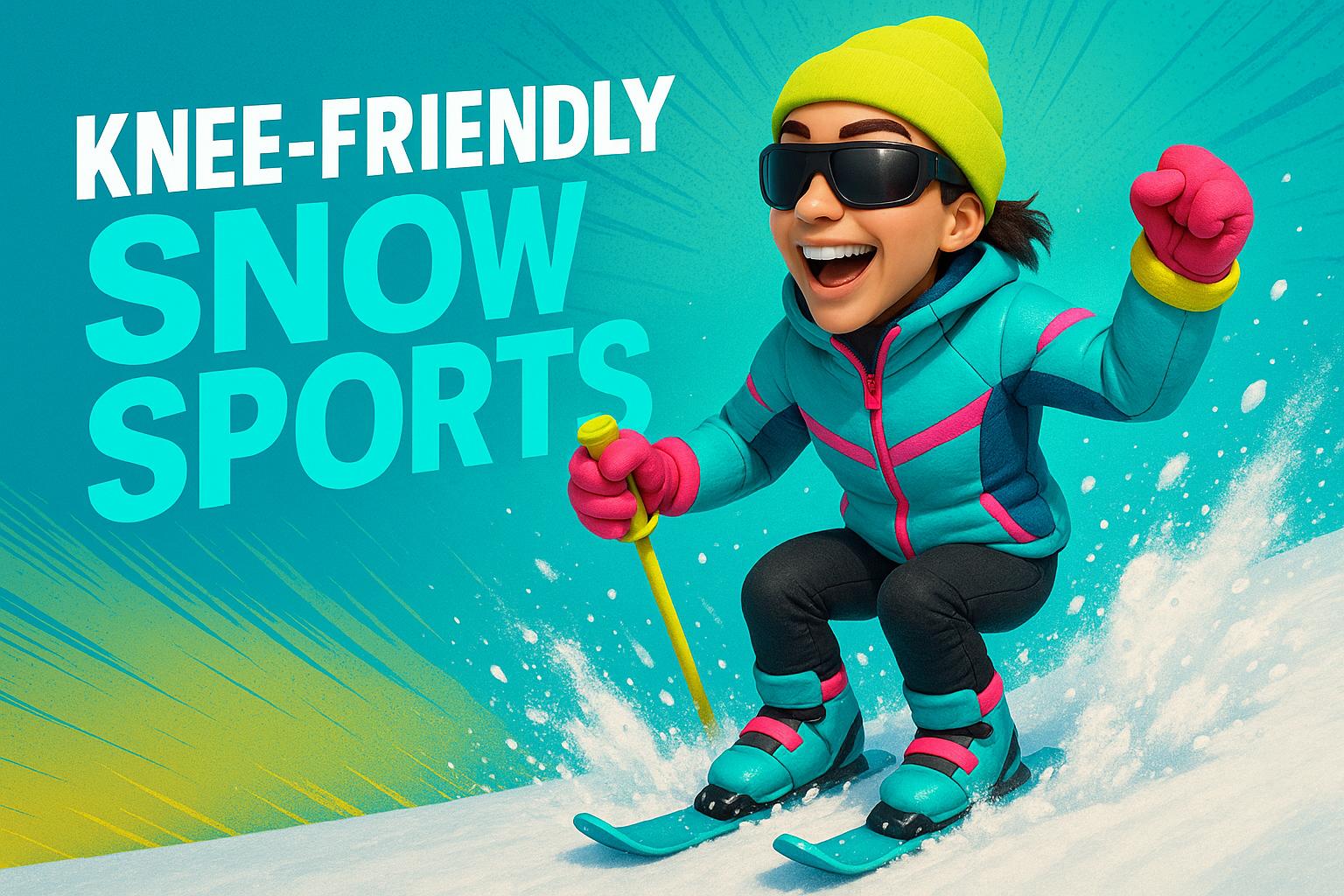
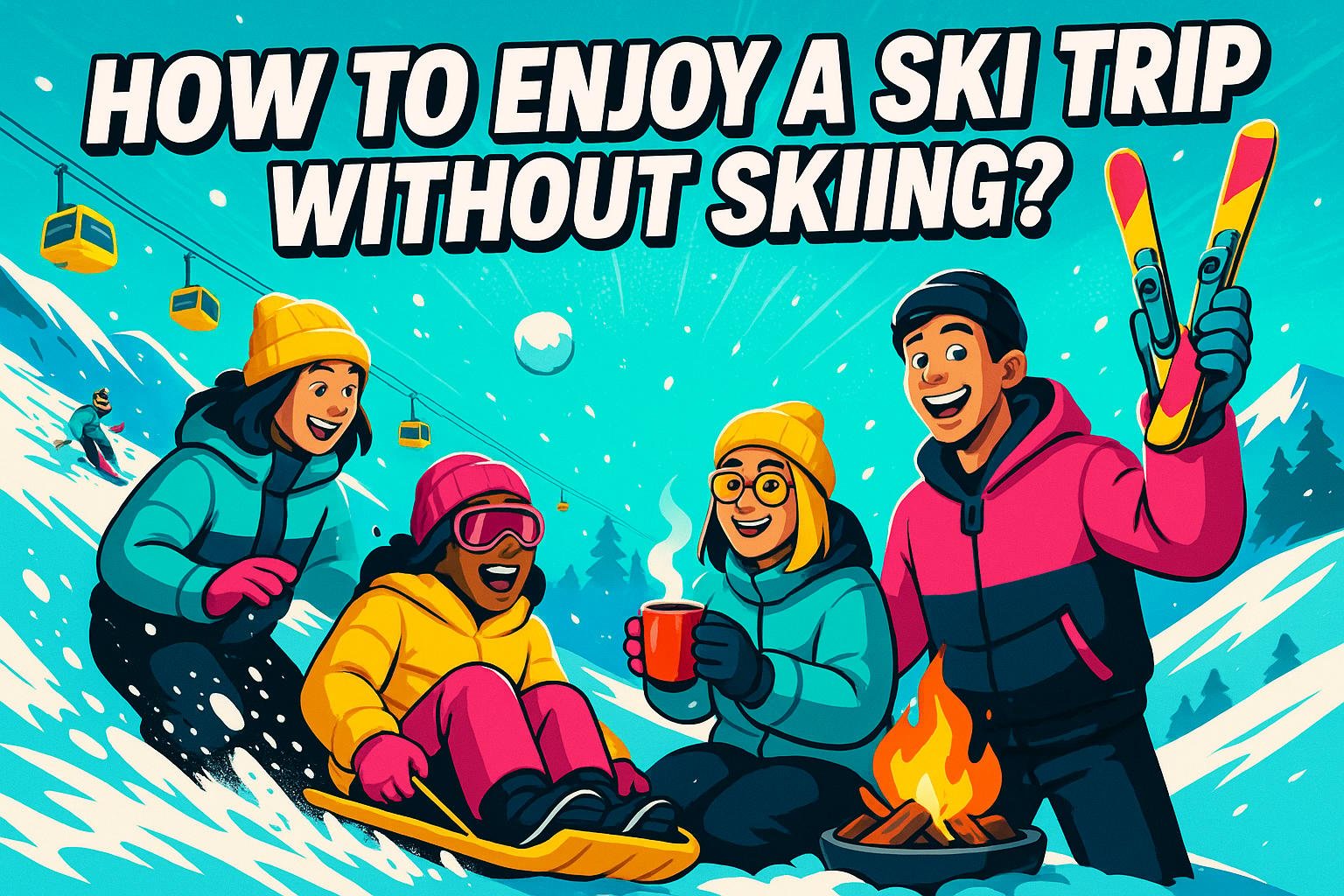










Leave a comment
This site is protected by hCaptcha and the hCaptcha Privacy Policy and Terms of Service apply.